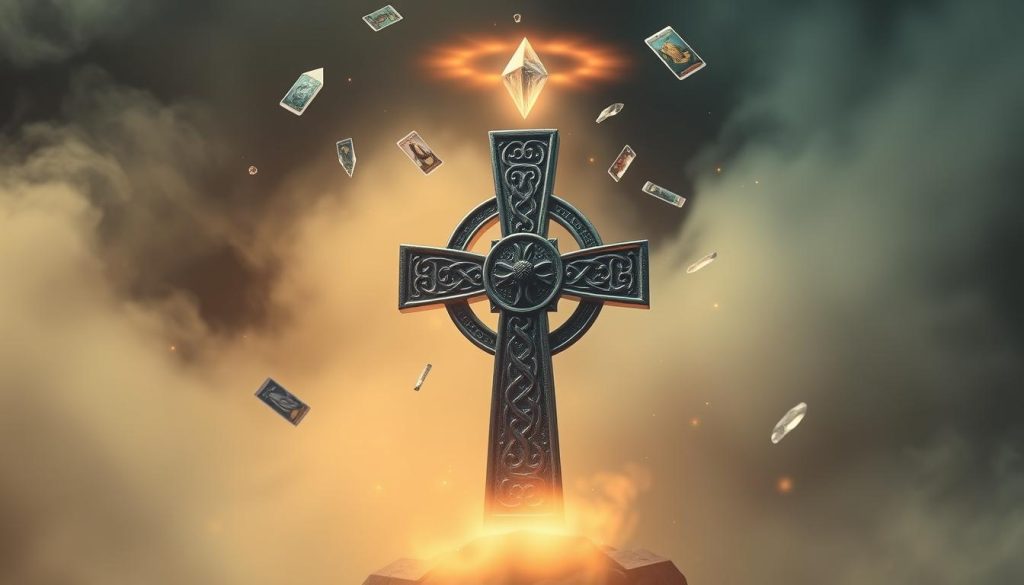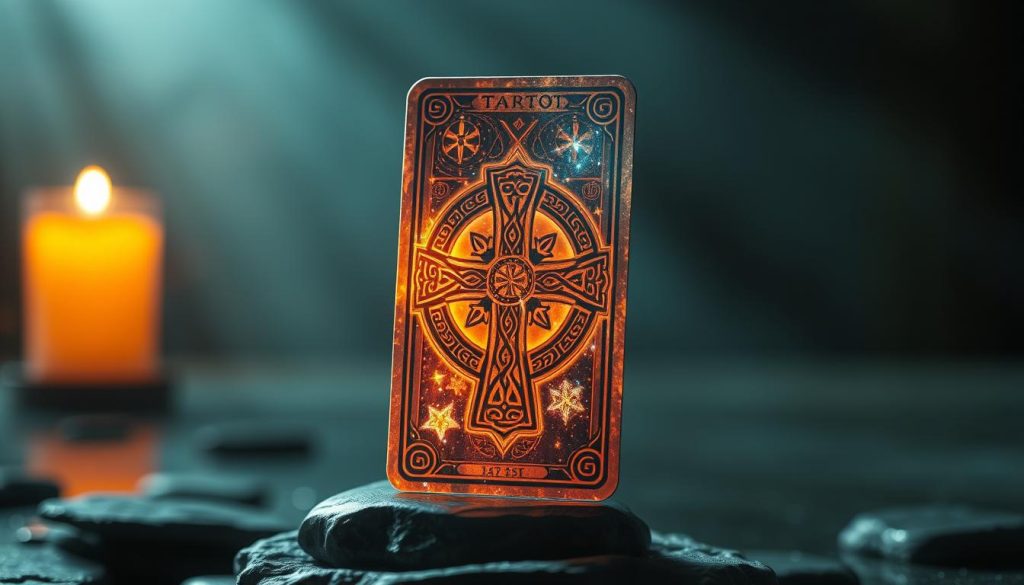Welcome. We’re opening a gentle, modern take on the classic celtic cross so you can read the cards with calm and clarity.
Quick note: this ten-card layout maps a situation across time and consciousness. Two central cards form an axis while four cards wheel around them, and four stack as a staff of influence.
In this short walkthrough we honor tradition and keep things practical. You’ll learn what each position means, how cards talk to each other, and why spotting patterns saves time.
Expect clear prompts, simple language, and friendly cues so you can lead a reading for yourself or a friend with quiet confidence. Ready to open the layout and meet the story unfolding in your life?
Why the Celtic Cross still matters in 2025 for clear, actionable tarot readings
This ten-card map gives us structure when life feels scattered. We start by seeing the big picture, then move to details. That order keeps readings useful, not dreamy.
Look first at groupings — present/challenge, past/future, perception/external, and hopes/fears/outcome. These pairs let us spot cycles and timing. They also reveal patterns that point to a clear next step.
In a busy world, this method slows us down. It helps frame the real question and shows which parts of an issue need attention now. We get practical insight that fits a calendar and a to-do list.
Seeing present and challenge side-by-side keeps us honest about what’s on the table. Comparing inner perception with the outside world bridges what we think with what actually is. That blend of intuition and logic makes readings feel both inspired and usable.

Use it when you need clarity on timing, people, emotions, or outcomes. The layout helps turn insight into action and makes the next move feel simple.
What the Celtic Cross tarot spread is and when to use this cross spread
This ten-card layout is a map for big, layered questions. It shows timing, mindset, outside forces, and likely outcomes all at once.
Use it when the querent wants the full picture — not a quick yes or no. It’s ideal for messy choices, relationship turns, career pivots, or moments where many influences overlap.
The format works even without a precise question. Ask, “What do I need to know right now?” and the structure will still deliver clear threads to follow.
Each of the ten positions has a role. That clarity keeps the reading grounded while intuition flows. Beginners may feel the layout is dense at first.
We’ll simplify how to read celtic so it feels natural. Seasoned readers will love the depth when they need strategy, not just comfort.

Setup essentials: tarot deck, space, and intention for a grounded reading
Create a simple, soothing setup so the cards can tell their story clearly. Choose a tarot deck you connect with. Rider-Waite-Smith imagery is helpful because symbolism is easy to read.
Make an environment that feels calm and safe. A tidy table, a candle, and a journal help shift the mind into a receptive state.
Set one clear intention in a single sentence. Try: “We’re inviting clarity for the highest good.” Say it out loud or write it down.
Turn off notifications and give yourself time. Grounded energy helps you hear what the layout is really saying.
Shuffle while holding your focus, then cut the deck in a way that feels natural. Keep water nearby—hydration quietly supports focus and intuition in real life.
If you read for someone else, agree on boundaries and consent. Names, pronouns, and comfort levels matter.
We like to open with three slow breaths together. It downshifts the nervous system and brings gentle attention back into daily life and the present state.

Celtic Cross Tarot Spread Explained: Step-by-Step Guide for 2025
Lay the deck one card at a time and speak each position aloud. This helps the querent stay present and makes the reading feel like a shared conversation.
Card 1 anchors the present — a snapshot of the querent’s current situation. Card 2 crosses it and names the core challenge or issue we’ll work through.
Card 3 brings in the past that still echoes. Card 4 points to the likely short-term future.
Card 5 surfaces conscious aims and assumptions. Card 6 opens hidden currents — beliefs and feelings moving below awareness.
Card 7 shows how self-view shapes choices. Card 8 reveals the room: friends, colleagues, and outside pressures.
Card 9 maps hopes and fears that color decisions. Card 10 is the outcome card — the likely outcome if current energies stay the same.
We link each card to its neighbor so details form a cohesive story. Keep checking with the querent: “Does this reflect how it feels right now?” Co-create clarity step by step.

Start with the big picture: recognizing patterns before card-by-card analysis
Before we name single cards, let’s lift our view and read the pattern across the table. This first pass gives fast insight and calms the moment.
We scan the spread for repeating suits, majors, and elemental clusters. Notice where movement or stasis appears. That shows momentum and friction at a glance.

Follow the horizontal line to spot how events want to unfold through time. Track majors versus minors to see what feels destined and what is daily choice.
Ask aloud: “What’s loud? What’s missing?” Silence in a suit can be just as meaningful as a cluster. Read like a constellation first, then zoom into the stars.
After this aerial view, we return to each position with clearer focus. That rhythm keeps the querent steady and the reading coherent, even when feelings run high.
The Cross vs. The Staff: mapping inner dynamics and life context
Think of the table as two conversation partners. The left six cards form the cross — the engine room of the situation.
They show what’s churning inside and what external currents touch that inner space. Read them as close-up energy: feelings, blocks, and nearby causes.
The right four cards act as the staff. These positions give altitude. They reveal how life and external influences shape choices and timing.
Seeing both sides together stops us from blaming only the self or only the world. We move from the cross to the staff to turn insight into a practical plan for the week.
When energy feels stuck in the cross, the staff often points to people, resources, or angles that open a door. That balance makes the celtic cross intimate and panoramic at once.

We finish by rebalancing inner work and outer action so progress feels grounded and doable.
The Wheel and its Axis: central focus with surrounding life events
The axis is where the question breathes; the surrounding cards are its moving weather. We read the two central cards first. One names the present core. The crossing card reveals the main tension or test.
The four cards around them act like seasons of events. They orbit the center and show where energy is moving across time. If a single suit repeats, that theme is asking for attention in daily choices.
When a court card sits on the axis, people dynamics matter most. When a major card lands there, fate or a larger lesson is speaking loudly. Heavier cards near the axis hint at what’s pressing versus what can wait.
We check whether the wheel supports or strains the center. That contrast points to practical next steps and priorities. Read the layout as a living diagram: one side shows pressure, the other shows openings.
Finally, note one small shift that strengthens the axis — a mindset tweak, a boundary, or a simple action. Strengthening that core helps the whole spread turn more smoothly and makes the story easier to work with.

Time and Consciousness: reading horizontal and vertical lines
We can read the layout as two simple stories: one about when events happen, the other about how the mind holds them.
The horizontal line maps time — past influences, the present pulse, and likely future movement. Read the central axis as part of that left-to-right timeline. Treat these three cards like a mini-spread that shows sequence and momentum.

The vertical line reveals consciousness. From the unconscious root up through the self to conscious awareness, these cards show inner layers. Read them as a second mini layout to see what the querent feels versus what they know.
When the horizontal feels heavy with the past, we pick one small behavior to free momentum today. If the future card seems stuck, look at vertical inputs that can shift it.
Use positions along both lines as checkpoints. Ask: how can the mind align with the current of time instead of swimming upstream? This split makes any reading calmer and more actionable.
Key comparisons that unlock depth in your tarot spread
A few side-by-side looks often unlock a whole new level of clarity. We use pairs to turn broad symbolism into a clear experiment to try.
Bridge near future to outcome: compare Card 4 and Card 10. Ask what small action moves the near future toward the outcome card. Name one step you can try this week.
Conscious vs unconscious: place Card 5 beside Card 6. See where desire aligns or conflicts with hidden motive. Notice what each card represents in lived behavior, not just ideas.
Belief and feeling: link Card 6 with Card 9 to reveal how buried beliefs shape hopes fears. When the pair disagrees, that tension is useful—tweak one habit and watch momentum shift.
Watch repeating imagery across these cards. That theme wants attention first. Track people and places that act as influences across pairs. Finish by writing one sentence that sums the comparison as a clear, testable action.

From insight to story: crafting a narrative and course of action
We stitch the cards into a short story so insight becomes a practical plan. Read the table like a tiny novel: a beginning that names the situation, a middle that shows tests and allies, and an end that points to an outcome.
Look across the whole spread and summarize it in one clear sentence. Then ask: what is the smallest course action that nudges events toward the outcome you prefer? Name one tiny habit or conversation you can try today.

When a relationship theme appears, name the pattern out loud. Pick one compassionate boundary and one honest line you can say. That single chat often shifts energy more than ornate plans.
Write one short paragraph in your journal that tells the story in your words. Assign timelines — today, this week, this month — so the reading stays alive. Revisit in two weeks to note change. This turns insight into a lived experiment that feels both magical and practical.
Applying the Celtic Cross to relationship and career readings
Apply this layout to heart and career questions and you’ll find clear entry points for action.
When a reading centers on a relationship, frame the question around what you can influence. Avoid trying to control another person. We name small, kind behaviors you can try instead.
Watch Card 5 and Card 6 for internal alignment. Card 8 often shows external influences like family, work, or social pressures. Use the near future as a map of likely conversation windows to repair, reconnect, or release with compassion.
The outcome in relationship readings reads like a trajectory, not a decree. Active listening and clear boundaries can tilt that path. Name one tiny habit that honors your needs and keeps things honest.
For career readings, define the core issue—role fit, growth, leadership, or transition. Map resources and allies in the staff. Card 7 often reveals confidence patterns; naming those frees interviews, pitches, and negotiations.
Track where collaboration helps and where solo focus serves better. Whether heart or work, keep the tone kind and honest. We use the layout to make living choices, not to predict fate—this is practical tarot that supports real change.

Working with Major Arcana: deepen meaning and intuition in readings
Major arcana cards bring a slow, deep voice to any reading—listen to their timing. When they cluster on the axis, destiny moments are in play. Pause, breathe, and let the narrative widen.
A single major often names the chapter. It colors how every other card represents its message. That makes small influences feel larger or small choices feel fated.
Use guided meditations to deepen this feel. Try the 20-minute practice for a single major or the 40-minute Fool’s Journey to sense arc patterns in the body. These tools help intuition land in clear language.
Cross-check majors with minor influences nearby. That grounds the epic in the everyday and shows what to do this week. If a major lands in outcome, expect a longer arc and looser timelines.
The workbook approach keeps symbolism usable. Worksheets for upright/reversed meanings, symbols, and life-area prompts make readings accurate and soulful. Pair study with short practice spreads to see how a major shifts tone across positions.

Learning resources to accelerate your tarot reading in the present
Choose a few high-quality resources, then practice them in short daily bursts.
Start with the 22 Major Arcana meditations (20 minutes each) and the 40-minute Fool’s Journey audio. These help you meet archetypes in body and imagination.
Pair audio with the 150+ page guidebook and the Tarot Card Meanings Workbook. The workbook shows all 78 Rider-Waite images and gives worksheets for love, career, and well-being.

Follow The Ultimate Guide to Tarot Card Meanings for quick keywords and upright/reversed notes. Use Tarot 101’s ten bite-sized lessons to move from theory to confident practice.
Want to read celtic faster and clearer? Use meditations before you lay a cross tarot spread. Study one card a day and log your experiments.
Keep it playful. Build a shelf of audio, PDFs, and quick charts. Small, steady practice turns curiosity into reliable readings you can trust.
Common mistakes to avoid when you read the Celtic Cross
Small missteps in reading can shift meaning and stall useful insight. We often leap to one position and miss the full table. That rush can amplify the challenge instead of naming a clear next move.

Don’t treat the outcome card like a verdict. It’s a weather report, not fate. If we lock onto a single dramatic card, we may ignore the supportive cards that suggest small actions.
Keep a simple key so you never forget which position you’re reading. Mixing up positions sends mixed signals and weakens our advice.
Remember context. Skipping context from past events can make the present look random. Reading only for reassurance—rather than clarity—lets the same issue loop.
Slow is smooth, smooth is accurate. Notice contradictions between positions; that tension often points to the real issue. Take a breath, scan the whole spread, then name one small testable step. That keeps the reading useful and kind.
Pro tips for accurate, confidence-building tarot readings
Start by naming a clear intention together: clarity, choice, or timing. When we align with the querent at the start, the session stays focused and kind.
Name external influences out loud. Call people, timing, or pressures by their names. Sunlight on the facts makes them easier to navigate.
When hopes and fears collide, write both down. Owning that paradox calms reactive choices and gives a simple map to work from.
Ask the querent to reflect one insight back in their own words. Teaching a point helps it stick. That short act builds memory and trust.
Track tiny, testable micro-outcomes over two weeks. Note small wins. Confidence is cumulative—tiny wins build big self-trust.

If anxiety spikes, pause. One breath. One card. One sentence. Then continue. Close the reading with a single practical action and a gentle check-in date to review the likely outcome.
Your path forward in 2025: read the Celtic Cross with clarity and confidence
Invite the cards, then pick one small move you can try this week.
Bring your tarot deck to hand, set your mind, and name the situation and question with care. Walk each position slowly. Honor past, future, inner motives, and external influences.
Let one card represent your next move. Check the near future and outcome card to refine timing. If relationship themes appear, tend them with tenderness and truth.
Close with a single course action you can hold in your hand. Save this guide, share a snapshot of your spread, and visit MysticBolt.com to explore readings, tools, and playful practice together.
Looking for more Tarot depth and daily practice? Start with our Tarot hub for spreads, meanings, and tips: https://mysticbolt.com/category/tarot/ . Then explore quick, interactive tools in Mystical Fun & Free Apps: https://mysticbolt.com/category/mystical-fun-free-apps/ . For bigger journeys, see Manifestation & Visualization to pair cards with goals: https://mysticbolt.com/category/manifestation-visualization/ . Next, decode repeating numbers and timing with Numerology & Angel Numbers: https://mysticbolt.com/category/numerology-angel-numbers/ . If you want zero-cost practice, browse our Free Apps hub: https://mysticbolt.com/category/free-apps/ . Finally, go deeper with premium readings and pro tools in Member Apps: https://mysticbolt.com/category/member-apps/ .
